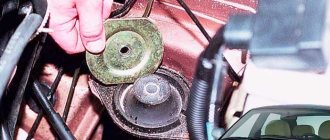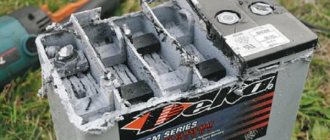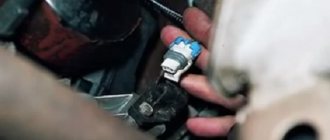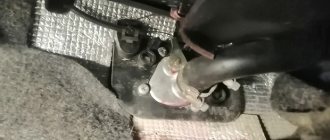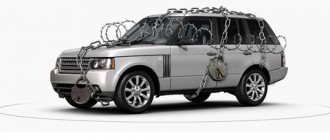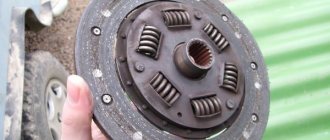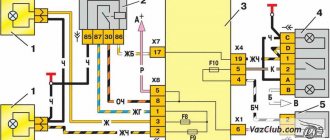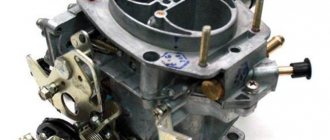On these machines, VAZ 2101 to 2107, the principle of engine removal is the same. If you decide to remove the engine yourself at home, without any equipment, and don’t know how to do it correctly, then this article is for you.
The engine has to be removed to overhaul it, or to replace it with another engine.
You look at the engine and the first feeling is that it is difficult to remove the engine from the car, but in fact everything is very simple, two men can easily remove the engine themselves at home and also put it in place. I will give an example of removing an engine from a VAZ 2106, although this principle is suitable for VAZ2101 to 2107.
The engine can be removed entirely, but this is much more difficult, or you can remove it without the head, this is much easier. If you decide to repair the engine yourself, then the second option is preferable, since you have to disassemble the engine anyway and why drag out the extra weight. I will describe the removal of the engine with its partial disassembly, in the engine compartment of the car.
The reason for removing the engine was that the splines on the oil pump drive gears on this six were torn off, and the driver drove on without oil pressure, and the engine jammed.
Engine removal sequence
Immediately remove the hood of the car so that it is not in the way.
Photo. The arrow shows which nuts need to be unscrewed to remove the hood.
After removing the hood, drain the coolant; to prevent the liquid from draining onto the ground, place a basin under the engine.
Photo. The arrow shows the bolt that must be unscrewed to drain the coolant from the engine block.
Photo. Now we remove the air filter, disconnect the choke cable, remove the throttle levers, the gas line from the carburetor, the valve cover, and disconnect the radiator pipes from the block.
Photo. Unscrew the muffler and remove the stove pipe.
Photo. Unscrew and remove the camshaft, distributor and head.
Photo. Unscrew and remove the heater pipe and the starter.
Photo. Remove the radiator.
Photo. Remove the fuel line from the fuel pump, and the plug from the oil pressure sensors, and unscrew the nuts from the engine mounts, they are shown by the arrow.
Photo. Now unscrew the box from the engine, two bolts on top are marked with an arrow, and two on the bottom, the bottom bolts can be unscrewed with a 19mm spanner. You can crawl up from below on the left and right sides of the car. And don’t forget to unscrew the bolts from the box boot.
Photo. Pull the engine off the cushions by swinging it left and right and place belts or rope under the cushions.
Now everything is ready to remove the engine without the box; you can insert a pipe under the belts or rope and use it to pull the engine out. But it’s easier to pull out the engine in a different way, climb straight onto the car, but don’t stand on the wings themselves, but put your feet in the corners where the wings connect, grab the belts with your hands, and lift the engine, jerk forward, usually the engine immediately comes out of the gearbox. It rarely happens that the engine does not immediately come out of the box, you pull and swing it to the sides and the engine comes out of the box.
Photo. Removed engine from car.
Removing and disassembling the engine from a VAZ 2107. Video
Gorobinsky S.V.
Particularly small class cars VAZ and SeAZ “Oka” 1111 and 1113 were the only models of the domestic automobile industry that were equipped with two-cylinder water-cooled power plants. These motors were very compact and structurally very well made.
But, like any power unit, Oka engines required major repairs after long-term operation. Moreover, some of the restoration work, especially the crank mechanism and the cylinder-piston group, is much easier to perform with the engine removed, so you definitely need to know how to remove the engine from the Oka.
In general, removing the engine from the Oka is not a difficult operation, but you need to know the sequence of actions. You will also need the appropriate equipment.
Removing Attachments
Also, for the convenience of performing work, it is better to drive the car into an inspection hole. Immediately after this, the negative terminal from the battery is removed.
Before starting work, you need to drain the engine oil and coolant system.
To make it more convenient to remove and disconnect engine attachments, you must remove the hood from the car. This will provide better access to the upper hanging elements.
Then all pipes and wiring from the engine are disconnected - the cooling system pipes going to the engine from the radiator, the pipes going to the stove.
As for the wiring, you will need to disconnect all connections going to the sensors:
- oil pressure,
- coolant temperature,
- carburetor solenoid valve,
- spark torque sensor,
You will also need to disconnect the wires from the spark plugs, starter, and generator. In the future, the generator will have to be completely dismantled.
| 4. Removing the coolant sensor | 5. Removing the solenoid valve |
| 8. Disconnecting high voltage |
You will also need to disconnect:
- fuel pipe from the fuel pump,
- brake booster hose,
- air filter housing from carburetor,
- from the carburetor itself - the throttle and air damper drive cables.
In general, removal of the Oka engine should be accompanied by preliminary dismantling of the gearbox and drive, but this may not be necessary.
Since the engine will still be disassembled, the method of removing the engine without a gearbox will require removing the cylinder head before removing the engine from the car.
| 10. Removing the carburetor pipe | 11. Removing the brake vacuum hose and manifold heating | 12. Removing the air filter housing |
| 13. Removing the air damper drive | 14. Removing the throttle drive |
website about a little bit of everything
REMOVAL AND INSTALLATION OF ENGINE
Place the car on a lift or over an inspection ditch, place supports under the front wheels and hang the rear axle on one or both sides.
Remove the hood, disconnect the wires from the battery and from electrical components installed on the engine. Remove the battery and engine compartment lamp.
Drain the coolant from the radiator, cylinder block and heater, for which, unscrew the drain plugs on the left side of the cylinder block and on the left radiator tank (for a brass radiator on the lower tank), remove the plugs from the expansion tank and radiator and move the upper heater control lever to the right (they open the heater tap).
Rice. 2-3. Engine mount: 1 — support casing; 2 — front engine mount support; 3 — cylinder block flange; 4 — bracket; 5 — intermediate plate; 6 - insulating plastic ring; 7 — support spring; 8 - buffer; 9 — support cushion; 10 — washer; 11 — rear engine mount support; 12 — spacer sleeve; 13 — cross member of the rear engine mount
WARNING
If the car is equipped with a brass radiator, then in order not to damage it, when unscrewing the drain plug, hold the plug fitting soldered into the radiator with a second key. Unscrew the plug with a socket or socket wrench so as not to tear off the edges of the plug.
Disconnect the coolant inlet and outlet hoses from the engine and remove the radiator along with the thermostat, hoses and fan motor.
Remove the air filter by first disconnecting the hoses from it, removing the cover and filter element. Close the top of the carburetor with a technological plug.
Using a spanner, unscrew the nuts securing the front muffler pipe to the exhaust manifold.
Remove the gearbox as described in the “Gearbox” chapter.
Disconnect the carburetor throttle linkage and the choke control cable from the engine.
Disconnect the fuel supply hose and the hoses going to the heater from the engine.
Hang the TSO-3/379 traverse on the hoist and sling the engine on the right side through the bracket installed on the front stud of the exhaust manifold, and on the left side - behind the clutch cover mounting hole.
Lightly tension the hoist chain, unscrew the nuts securing the mounts 9 (Fig. 2-3) of the front engine mount to the cross member of the front suspension and remove the engine from the compartment.
Remove the starter heat shield, starter and hot air intake along with the supply hose. Remove the two side brackets with the front engine mount cushions from the cylinder block.
Unscrew the clutch mounting bolts and remove it.
Install the engine on the car in the reverse order of removal. Pay special attention to the connection between the engine and the gearbox: the input shaft must fit exactly into the splines of the clutch driven disc.
ENGINE DISASSEMBLY
Wash the engine in a washing machine, place it on a disassembly stand and drain the oil from the crankcase.
Remove the carburetor by disconnecting the hoses and throttle linkage from it.
Remove the fuel pump, ignition distributor, use wrench 67.7812.9514 to unscrew the spark plugs and coolant temperature gauge sensor.
Remove the generator and coolant pump drive belt, remove the generator and generator bracket.
Remove the coolant pump by disconnecting the coolant supply line from the heater from the pump and exhaust manifold.
Remove the coolant outlet pipe and the coolant drain pipe to the heater from the cylinder head.
Using tool A.60312, unscrew and remove the oil filter with gasket (Fig. 2-4).
Unscrew the pointer sensors and control lamp -
Rice. 2-4. Removing the oil filter using tool A.60312
check the oil pressure, remove the sensor fittings. Remove the crankcase breather cap, crankcase and oil pump. Remove the oil separator drain pipe clamp and remove the crankcase ventilation oil separator.
Rice. 2-5. Unscrewing the crankshaft nut with wrench A.50121
Remove the crankshaft pulley by securing the flywheel with clamp A.60330/R (see Fig. 2-10) and unscrewing the nut with wrench A.50121 (Fig. 2-5).
Remove the cylinder head cover and camshaft chain drive cover. Remove the bolts securing the camshaft sprockets and the oil pump drive shaft.
Rice. 2-6. Removing the chain tensioner and damper: 1 - camshaft drive chain; 2 — shoe fastening bolt; 3 — tensioner shoe; 4 — tensioner fastening nut; 5 — tensioner body; 6 — tensioner cap nut; 7 — damper mounting bolts; 8 — oil pump drive shaft sprocket bolt
Loosen the cap nut 6 (Fig. 2-6) of the chain tensioner, unscrew the nuts 4 securing it to the cylinder head, remove the tensioner and, having unscrewed the bolt 2, remove the chain tensioner shoe 1.
Unscrew the chain stop pin, remove the oil pump and camshaft drive sprockets and remove the chain.
Rice. 2-7. Removing the camshaft thrust flange: 1 - thrust flange; 2 - camshaft; 3 — bearing housing; 4 — stud for fastening the thrust flange
Loosen the nuts of the studs 4 (Fig. 2-7). After unscrewing the fastening nuts, remove the camshaft bearing housing. After unscrewing the nuts of the studs 4 and removing the thrust flange 1, carefully so as not to damage the surface of the bearing housing supports, remove the camshaft.
Unscrew the cylinder head bolts and remove it along with the exhaust manifold and intake pipe.
Rice. 2-8. Removing the oil pump drive shaft: 1 - thrust flange; 2 — flange mounting bolt; 3 — oil pump drive shaft; 4 - key
Remove the thrust flange 1 (Fig. 2-8) of the oil pump drive shaft and remove the shaft from the cylinder block.
Using the universal puller A.40005/1/7 from kit A.40005, remove the sprocket from the crankshaft (Fig. 2-9).
Rice. 2-9. Removing the crankshaft sprocket using a universal puller
Unscrew the nuts of the connecting rod bolts, remove the connecting rod caps and carefully remove the pistons with connecting rods through the cylinders. Mark the piston, connecting rod, main and connecting rod bearing shells so that they can be installed in the same place during reassembly.
Rice. 2-10. Removing the flywheel: 1 - key; 2 - flywheel; 3 — flywheel mounting bolt; 4 — washer; 5 — clamp A.60330/R to keep the flywheel from turning; 6 — front cover of the clutch housing
Install the clamp 5 (Fig. 2-10), unscrew the bolts 3, remove the washer 4 and the flywheel from the crankshaft. Remove the front clutch housing cover.
Rice. 2-11. Pressing out the gearbox shaft bearing from the crankshaft using ejector A.40006
Using pusher A.40006, remove the gearbox input shaft bearing from the socket in the crankshaft (Fig. 2-11).
Remove the crankshaft oil seal holder.
Unscrew the bolts of the main bearing caps, remove them together with the lower bearings, remove the crankshaft, upper bearings and thrust half-rings on the rear support.
avtopomohc.ucoz.ru
Then you need to move under the car
Removing engine mounting elements
First you will need to unscrew all the bolts securing the clutch housing from the power unit.
16. Removing the clutch housing
Then you should proceed to the engine mounting elements.
To do this, you will have to unscrew the bolts securing the motor mounts. First, the nut is unscrewed from the bolt on the front support. Since the power plant continues to rest on this support, in order to be able to pull out the bolt, the engine should be lifted slightly using a pry bar and the bolt removed. Next, holding the unit with a pry bar, insert a wooden block into the gap between it and the subframe. After this, it will be possible to unscrew the engine bracket mounting bolts.
| 17. Removing the front engine mount | 18. Lifting the engine with a pry bar, remove the bolt | 19. To unload the bracket, we place a block |
| 20. Using the “17” head, unscrew the 3 bolts securing the bracket | 21. Bracket mounting bolts when removed | 22. Remove the bracket with support |
In the same way, the rear right support becomes loose, followed by installing it on a wooden block and removing the bracket.
| 23. Using a 17 key, unscrew and remove the bolt | 24. Unscrew the 2 bolts securing the rear support bracket | 25. Remove the rear support |
26. Removing the rear mounting bolt of the clutch housing is possible only after dismantling the rear support.
The photo shows a removed engine Removing the left engine mount
| 27. Place a block | 28. Using a key set to “13”, unscrew the nuts securing the left support bracket to the gearbox |
| 30. Take out the support |
The lifting mechanism is hooked onto these eyelets. To remove the motor, you need to move it all the way to the left so that the gearbox input shaft comes out of the flywheel. It is quite possible that for this you will have to tilt the engine a little, and at the same time moving it to the left.
After the shaft comes out of the flywheel and clutch discs, the power unit is carefully lifted up by the lifting mechanism. It is better to do this together - one will lift the motor, and the second will guide it so that it does not cling anywhere.
Reasons for dismantling the power unit
Engine removal is carried out for various reasons. Often, to carry out repair and restoration operations, but if the motor is old and cannot be repaired, it is removed to install a new one. Let's consider and describe the main reasons why it is necessary to remove the power unit:
- Wear. This is the most common reason for engine dismantling. Wear leads to the fact that the engine requires restoration, which most people know as a major overhaul. So, the engine is removed from the car and then disassembled.
- Cracks in the cylinder block caused by mechanical damage. In this case, the unit must be removed from the vehicle to replace the unit.
- A traffic accident often leads to deformation of the body, which cannot be eliminated without dismantling the main power unit. Of course, repeatedly, when major damage occurs, the body itself, as well as its structural elements, suffers.
- Other reasons, the elimination of which will require removing the engine from the car.
After considering the immediate reasons for removing the engine from the vehicle, we can move on to considering the processes of removing the engine from the car.
Diesel engine replacement
A diesel engine, especially of previous years of production, is replaced according to the same scheme as injection engines, with the exception of the point about the ignition system, which is absent on diesel engines, and there is also a difference in replacing the fuel system, the design of which has its own differences. The design of a diesel engine includes a turbine, the replacement of which is the main difficulty when dismantling the engine. The right choice would be to entrust the work of replacing a diesel engine to service station specialists.
Removing the motor
Many car enthusiasts ask the question: how to remove the engine? The installed engine can be removed from the car at a car service by professional specialists or with your own hands in your garage. So, dismantling it yourself will take approximately 8-10 hours.
But, if the vehicle has a lot of electronics and the power unit is equipped with it, then it is not recommended to carry out the operation yourself, but rather turn to professionals. So, let's look at the process of removing the engine on the simplest versions of cars.
How to remove a gasoline engine
Removing a gasoline engine, for example VAZ or ZMZ models, is quite simple. The first recommendation is that this process should be carried out with 4 hands, since it will be difficult for one person to do it. So, let's consider the sequence of actions for removing a VAZ-type unit:
- For more comfortable operations and less time, it is recommended to carry out the process on a lift, pit or overpass. Also, it is necessary to collect tools, namely: a set of keys, screwdrivers and sockets, a hoist or winch, and containers for draining liquid.
- The first thing you need to do is remove the battery and also unscrew its shelf. At the same time, you can remove the air filter housing, as well as the air ducts.
- The second stage is draining all liquids. To do this, you need to remove the motor protection (if any), and, placing containers under the drain necks, unscrew the plugs. For a standard engine, coolant (10 liter container) and engine oil (up to 6 liter container) are drained.
- After the liquids have been removed, it is worth starting to disassemble the unit to dismantle it.
- In the first stage, it is necessary to remove the generator, starter, all drive belts, and battery wiring.
- Now we begin to remove the elements of the cooling system: thermostat, water pump, expansion tank, coolant system pipes.
- Next, we dismantle the ignition system - spark plugs, wires, distributor, injector.
- After this, we disassemble the fuel system, namely, remove the carburetor or fuel rail with injectors, power supply pipes, and intake manifold.
- Another important step is dismantling the cylinder head. First you need to remove the camshaft pulley. After unscrewing the bolts, remove the valve cover, and then the cylinder head itself.
- We hook the motor to the winch and firmly fix it.
- Unscrew the gearbox from the engine. In this case, the clutch should remain on the power unit.
- We unscrew the nuts securing the pillows and lift the engine, carefully removing it from the engine compartment.
- Reinstalling the motor is carried out in the reverse order.
This is how, at first glance, it is easy and simple to dismantle the motor, but as practice shows, not everything is so easy. In the case of engines where there are many wires, you have to disconnect them from the sensors. Well, when the motor has too much wiring, then you should turn to professionals.
What engines were the first VAZs equipped with?
“Kopeykas” were equipped with two types of power units: 2101 and 21011. The design of the first was borrowed from the Italian Fiat-124. But this was not a copy, but a real improved version, although the camshaft was modernized. Unlike the Fiat, in which it was located at the bottom of the cylinder head, in the VAZ 2101 the shaft was located at the top. The working volume of this engine was 1.2 liters. It was capable of developing a power of 64 hp. s., which was plenty at that time.
The design of the “penny” engine was borrowed from Fiat
The VAZ 2101 engine differed from its predecessor in volume, which increased to 1.3 liters, and, accordingly, in the size of the cylinders. This did not lead to a significant improvement in power characteristics, however, it was this unit that became the prototype for subsequent modifications, namely 2103 and 2105.
The VAZ 2101 engine has four cylinders arranged in one row
Table: main characteristics of VAZ 2101 and VAZ 21011 engines
| Positions | Indicators | |
| VAZ 2101 | VAZ 21011 | |
| Type of fuel | Gasoline A-76, AI-92 | Gasoline AI-93 |
| Injection device | Carburetor | |
| Cylinder block material | Cast iron | |
| Cylinder head material | Aluminium alloy | |
| Weight, kg | 114 | |
| Cylinder arrangement | Row | |
| Number of cylinders, pcs | 4 | |
| Piston diameter, mm | 76 | 79 |
| Amplitude of piston movement, mm | 66 | |
| Cylinder diameter, mm | 76 | 79 |
| Working volume, cm3 | 1198 | 1294 |
| Maximum power, l. With. | 64 | 69 |
| Torque, Nm | 87,3 | 94 |
| Compression ratio | 8,5 | 8,8 |
| Mixed fuel consumption, l | 9,2 | 9,5 |
| Declared engine life, thousand km. | 200000 | 125000 |
| Practical resource, thousand km. | 500000 | 200000 |
| Camshaft | ||
| location | top | |
| valve timing width, 0 | 232 | |
| value of the exhaust valve advance angle, 0 | 42 | |
| intake valve retard, 0 | 40 | |
| diameter of seals, mm | 56 and 40 | |
| width of seals, mm | 7 | |
| Crankshaft | ||
| Neck diameter, mm | 50,795 | |
| Number of bearings, pcs | 5 | |
| Flywheel | ||
| outer diameter, mm | 277,5 | |
| bore diameter, mm | 256,795 | |
| number of ring teeth, pcs | 129 | |
| weight, g | 620 | |
| Recommended Engine Oil | 5W30, 15W40 | 5W30, 5W40, 10W40, 15W40 |
| Engine oil volume, l | 3,75 | |
| Recommended Coolant | Antifreeze | |
| Coolant quantity, l | 9,75 | |
| Timing drive | Chain, double row | |
| Cylinder operating order | 1–3-4–2 | |
How to remove a diesel engine
Dismantling the diesel heart of the car is carried out by analogy with the gasoline one. The difference is that diesel power units are often equipped with a turbine, which must be removed before dismantling the fuel system.
Another difference is the injection system itself. So, instead of an injector, a diesel engine has a high-pressure fuel pump, which is usually located on the cylinder block itself. It's not that difficult to remove, but you shouldn't forget about it because it weighs down the engine.
Often, especially on older diesel products, the body also houses the oil and gasoline fine filters. They must be removed after draining the lubricant.
Many auto repairmen recommend removing the exhaust manifolds from the power unit, which get in the way when the engine is removed from the engine compartment. If we talk about diesel engines installed on trucks, this is done to reduce the weight of the product.
Legal engine registration
Installing a new unit is not yet a completely resolved replacement problem; do not forget about the laws; the new engine will need to be included in the technical passport of the car.
Since the serial number of the unit is often indicated in the registration certificate, and if it does not match on the unit and in the document, it threatens with a fine or confiscation of the car. If the engine is replaced with a more powerful one, then this will need to be made to changes in the design of the car and there is no way to do it without an expert.
It is advised to consult with an expert before starting the replacement and find out which engines are allowed for your car.
Video of how to remove an engine on an Infiniti FX in a workshop:
Conclusion
How to remove the engine from a car? Removing a power unit from a car with your own hands can be simple and at the same time difficult, since it all depends on the type of power unit, as well as the presence of heavy electronics.
In the case of VAZ, GAZ, UAZ engines, they can be easily removed, but with foreign-made engines, everything is much more complicated. Therefore, most manufacturers recommend contacting specialists who can help remove the motor and repair it.
This guide is suitable for owners of all Classics. These are VAZ cars: 2101, 2102, 2103, 2104, 2105, 2106, 2107. The principles are common for removing the engine from other domestic models, as well as for foreign cars.
How to remove the engine of a VAZ 2107 at home? This question interests many car owners. This procedure is simple, but requires explanation. After all, there are subtleties and tricks, failure to comply with which can cause significant damage to your car. We present to your attention simple step-by-step instructions “in pictures” and with a video tutorial.
What is the liability for an engine that is not properly registered?
It is considered a violation to replace the engine with one that does not correspond to the make of your car without making changes to the Registration Certificate and PTS. In the absence of registration in accordance with Art. 12.1 of the Code of Administrative Offenses of the Russian Federation, a violator is punishable by a fine in the amount of 500 to 800 rubles. If, after checking the license plate, it turns out that the engine was removed from a stolen car or the license plates on the engine were destroyed, the car will be seized, placed in an impound lot and returning it will be very problematic.
How to replace a car engine was last modified: January 23, 2022 by Master
Removal: step-by-step instructions
Those who are faced with such a procedure for the first time often find themselves in this situation. They open the hood, looking at the engine and feel that the task ahead is of unprecedented scale. But in practice the situation is much simpler.
Two men in their garage can easily remove the old engine and put a new one in its place. You just need to know how to remove the engine on a VAZ 2107.
Immediate advice for beginners: the engine can be removed entirely. However, it weighs more than one hundred kilograms when assembled. And after removing it you still have to disassemble it. Therefore, sometimes it is easier to remove the engine and partially disassemble it directly under the hood.
- The first step is to remove the hood. Although this thing is quite useful during normal operation, when replacing the engine it will only hinder us. There are special nuts for removing the hood. But don’t rush to start twisting them right away. Remember, after finishing the work, the hood will have to be returned to its place. And in order not to make a mistake with its installation, apply special marks around the perimeter of the canopy with a black marker. This will help you save your nerves, which will no longer be enough at this stage of work.
- Use soft blankets to cover the front wings. This will avoid damaging the paint.
- Drain the coolant. To do this, use a hose and a canister. You don't want antifreeze to just be poured onto your favorite garage floor, do you? To drain the antifreeze, there is a special plug conveniently located on the cylinder block.
- Some people also advise draining the liquid from the radiator. But it’s better to put this bad thought aside. Most likely, your radiator tap has been clogged for a long time. And if you start to unscrew it, you will easily damage the radiator. So it's better not to touch him. The rest of the liquid is drained into the lower radiator pipe. After the antifreeze is drained, remove the pipes and take the radiator out of harm's way.
- We also don’t need electrical wires on the distributor, on the oil sensor, on the coolant temperature sensor and on the carburetor (if there is one). So, without regret, we remove them.
- And the fuel supply hose will also only get in our way for now. It must be removed by releasing the clamp using a screwdriver. Do you like the idea that gasoline can pour from this hose onto that very favorite and still clean floor in your garage? If not, then do not forget to lift the hose up and secure it in this position.
- The right side of the engine compartment was sorted out. Now it's the left's turn. You need to carefully unscrew the exhaust pipe. And here a new danger awaits us! The fact is that the factory nuts that are used to fasten the exhaust pipe are made of a very soft alloy. If you press a little, you can collapse the edges in one go. So you will have to apply your experience in unscrewing rusted nuts. And since you’ve decided to remove the engine yourself, we’ll assume that you’ve already learned how to twist the nuts too.
- It was the old starter's turn. It also needs to be removed, after first disconnecting the terminals from the battery. Three fastening bolts will help us unscrew the key to 13.
- You also need to disconnect the wires from the generator.
- Don't forget to remove the air filter housing as well.
- Our work on dismantling the car for spare parts is moving forward successfully. And the time comes to disconnect the engine from the gearbox. You don’t want to tear out your favorite gearbox along with the engine, roots and other contents, do you? To disconnect the parts, you need to use spanners bent to the side, which will easily unscrew the two upper bolts.
- While we are still above the hood, use a screwdriver to loosen the clamps of the heater radiator pipe.
- We remove the throttle from the gas pedal.
- Before going into the pit, we finally remove the choke cable if the car has a carburetor.
- By the way, a pit can be very useful to remove the engine. And if you have one, then you can easily go down into it, remove the clutch cylinder spring and, using a 13mm wrench, unscrew the two bolts.
- Now very carefully move the clutch cylinder to the side to remove it. And under no circumstances even think about accidentally pressing the clutch pedal. Otherwise, you will have to add a new chapter to your epic: a “joyful” overhaul of the working cylinder.
- Now comes the turn of the two bolts with which the gearbox is attached to the engine.
- And let's work a little more with the bolts. Where would we be without them? You need to tighten the bolts that secure the protective cover to the body.
- And a little more twist: you need to use a 17 socket to unscrew the nuts from the engine mounts.
- And only now, when all the preparatory work has been done, comes the culmination of our amazing adventure: we begin to remove the unit from the engine compartment. Place a jack under the gearbox and lift it slightly so as to remove the engine mounts from the mounting studs.
- We hook the motor with special belts and use talcum powder to lift it up a little.
- We put the box in first gear
- With light shaking movements using a winch or talc, remove the engine from the guides.
- When the unit comes off the guides, remove it.
- We roll the car to the side, brew a cup of coffee and relax, satisfied with the work done.
Of course, there is still a lot ahead of us: transportation of the engine to the place of major repairs or self-repair directly on site, installation of a repaired or new unit in place.
Basic maintenance of the motor is possible without dismantling it. Replacement of spark plugs, maintenance of intake and exhaust manifolds, and even replacement of the timing belt (chain) is carried out directly in the engine compartment of the car. However, work with valves, crankshaft, piston group, etc. is carried out only with the engine removed. Not to mention the overhaul procedure.
From our article you will learn how to remove the engine from a car in the garage, how you can remove the engine yourself and how to do it correctly.
The material was prepared by the site Auto-science.ru - whose specialists will help you check the mileage of your car efficiently and without errors.
Documentation of engine replacement
When talking about how to replace a car engine, you should understand that the engine is a numbered unit, and accordingly, its replacement should be reflected in the documents for the car, but not always. New registration rules were introduced in 2013, and according to them, the registration rules are different and depend on which engine is being replaced: with a similar one or with a different one. If the engine is changed to the same one as it was, that is, its markings do not change, then the engine number is not entered anywhere. But this number must be on the engine, otherwise, if the number is cut off or interrupted, this is a criminal offense and the car will be impounded. Therefore, it is advisable to follow all the rules, namely: the purchase of an engine must be documented, you must have a purchase and sale agreement for the engine and a receipt or other document confirming payment.
With these documents you apply to the traffic police, where your engine number is checked against the database in order to exclude the possibility that the engine was removed from a car that is on the wanted list. If everything is in order, the traffic police inspector will make a note in his database. In this case, the engine number will not be included in the Registration Certificate, because according to the new rules, the engine is not considered a numbered unit.
The registration procedure will be completely different if the engine has been replaced with another one that has different characteristics and different markings.
Such a replacement will require obtaining documents that will serve as the basis for permission to replace the engine with an engine of a different model. After installation, a technical examination will be required to confirm the serviceability and safety of the vehicle. The procedure for re-registration of a car in this case will be as follows:
- Applying to the traffic police with an application to make changes to the design of the vehicle. After reviewing the application, you will be given instructions to obtain a permit from the appropriate organization;
- Permits are issued by various organizations that have received the appropriate authority from NAMI. Including permission can be obtained from NAMI. The essence of the permit is confirmation of the ability to replace the engine with the selected model;
- Next, in a technical center that has the appropriate license to carry out such work, you must replace the engine. Completion of the replacement work is accompanied by the receipt of a declaration statement for the work performed. To re-register, you must obtain certificates from the organization that replaced the engine and a copy of its license. If you change the engine yourself, you also fill out the declaration form yourself;
- The next stage is passing a technical inspection, checking the technical condition and receiving a diagnostic card as a result;
- You present all the documents collected as a result to the traffic police along with the car for inspection.
What documents will you need from the traffic police:
- Vehicle passport and owner's passport;
- Purchase and sale agreement for the engine;
- Your application for changes to the design, signed by the traffic police inspector;
- The result of the examination;
- Statement-declaration of work performed to replace the engine;
- Result of maintenance;
- Certificates and a copy of the license of the organization where you changed the engine.
After reviewing your documents, the traffic police issues a Certificate of Compliance with the design of the vehicle and a Certificate of Registration of the Vehicle and PTS as amended.
Obviously, this process is lengthy, but it is necessary, because when you decide to sell the car, you will not be able to do so without the above documents.
How to remove the engine from a car in the garage without resorting to the help of a car service?
In fact, this is not such a complicated procedure as it might seem at first glance. The main task is to select tools for removing the motor.
Important!
The engine weighs several hundred kilograms.
Falling it can not only cause property damage, but also cause serious injury. Before lifting the engine from the engine compartment, it is necessary to carry out the following procedures:
- Drain all technical fluids: oil, power steering fluid, brake fluid.
- Free the cooling system from antifreeze.
- Drain the gearbox (except when you remove the engine without removing the gearbox).
- Disconnect all hoses and pipes of the fuel, brake, lubrication and cooling systems.
- If possible, remove attachments: air conditioning compressor, generator, etc.
- Disconnect electrical cables, engine control unit, injector control cables, high-voltage ignition coil wires.
- Remove the connectors from all motor sensors. It is recommended to make a list (“based on” the maintenance and repair instructions), this will help you not to miss a hidden connector.
- In most cases, you will need to remove the hood cover.
If you plan to remove the engine without the transmission, you need to unscrew all the tightening bolts and make sure that after removal the gearbox will not fall under the car. That is, you need to take care of temporarily securing the unit.
How to remove the engine from a car?
At home, there is usually no professional lifting equipment, so you will have to rent it or make it yourself.
Do-it-yourself goose for removing the engine
This is a simple mechanism that resembles a gooseneck. It makes it possible to move the engine away from the engine compartment. It may have a rotating design that allows you to remove the engine without moving the machine.
The heavy internal combustion engine is simply transferred to a workbench located next to the car. In fact, it is a universal garage crane. The rack rests on long “legs” located under the engine compartment to prevent it from tipping over. A cable and a winch are used for lifting.
The gander is used both in garage conditions and in small services.
DIY engine removal lift
As a rule, this is a rolling crane, the lower part of which is placed under the front bumper. A smooth platform is required; on uneven ground, removing the engine using such a device is problematic. The lift operates using hydraulics or a tensioning mechanism like a winch. The device is simple: a stand with rolling supports, and a movable boom on which the motor is suspended. You can make a lift with your own hands from a channel or a square professional. pipes.
If there are strong wheels on supporting legs, you can quickly roll out the lift with the motor and move it to the repair area.
Do-it-yourself winch for removing the engine
Applicable if the car is being repaired in a solid stone garage. The most inexpensive tool that can be used to remove an engine. A chain or cable is used to pull it out.
There are two design options:
- A transmission mechanism with a drum that is suspended from the ceiling.
- The winch is fixed to the floor, and a pulley is fixed under the ceiling.
Features of removing various motor designs
Longitudinal arrangement.
As a rule, such internal combustion engines are removed without a gearbox, although exceptions are possible. The radiator needs to be removed.
Transverse arrangement.
The motors are compact and easy to lift vertically. The gearbox remains on the engine.
Hybrid systems and electric vehicles.
Internal combustion engines in such machines take up little space or are absent altogether. Electric motors can be built into the wheel drive or integrated into the transmission. Due to their small size, their dismantling is not difficult.
All types of internal combustion engines are installed on supports. In frame structures, the attachment points are located on the frame; in cars with a monocoque body, there is usually a subframe.
Topic: Get / install a motor in a garage
Theme Options
- print version
- Send by email...
- Subscribe to this topic...
Get/put the engine in a garage
Good afternoon! You may have to pull the engine out and change the cylinder head gaskets. Since, apparently, the engine on a Subaru can often be pulled out for various reasons, I’m thinking about equipping the box in the parking lot with some kind of device so that I can carry out this operation myself, and take the already removed/disassembled engine to the mechanics if I don’t have something to do with it myself. I can do it (for example, grinding, replacing liners, etc.). Please advise whether this is worth worrying about. If so, where and what do you need to buy (I saw small hoists/cranes on wheels on the net for reasonable money) in order to remove the motor in the garage. Thank you in advance
Sir Tolik
the operation to remove and install the engine costs 6 thousand rubles on average (not in a garage, by knowledgeable craftsmen), but now think how many times in your life you will remove and install it. =) this is the same thing as doing tire fitting on the balcony..=)
Donorparts
I have a sad experience of repairs outside the home, if the option turns out to be completely crazy, I will refuse this idea
Cheap engine valves are available in Finnish Biltema.
Sir Tolik
Well then you need to go to a vocational school to study or to a station as a mechanic’s apprentice. But a sad experience, you know, is not avoidable since no one has canceled the human actor. You won’t be able to guarantee yourself that you won’t force it, despite the fact that the one-person engine on a Subaru is extremely inconvenient to install and remove, you need another pair of hands. It’s also a good idea to have a pit or a lift, since you need to unscrew the transmission from the engine and the engine cushion from the beam, drain all the liquids. etc.
I'll support you. otherwise you can “shit”))))
Sir Tolik
My opinion is nonsense! Buy a faucet for a couple of uses. not reasonable. Option: 1. hire an adequate man with a truck crane at a nearby construction site. 2. Find a garage with cross beams and stir everything through them. 3. come up with something on the ground that you can throw a rope over and..
A friend practiced the 2nd option, more than once, everything was good. The main thing is to fasten everything wisely. PS My friend was not the only one who did all this.
True, it wasn’t on Saturday, I removed the engine using a tractor with a bucket, wrapped it with a cable, hooked it to the bucket and it’s done. Well, if you are going to remove and install engine many times, then it makes sense to buy such a crane!
people are ready to break their ass for 6 thousand rubles)))) why is this necessary? You’re not preparing a rally car to constantly remove and install the engine, it’s better to find a normal service, at least you’ll get some kind of guarantee.
yes, I don’t tear anything, I like the process of digging in the car (of course, provided that I can put everything back together)
Sir Tolik
HERE!))) to the point, put it back together, otherwise it was like in childhood, and how is this magnet standing, I’ll take it apart and see that’s all!!))) and then this is where it’s from, where the spring is, and this is how it stood and that’s it arrived))
Sir Tolik
Do not listen to anyone! Everything can be removed normally, just jack up the gearbox and when you remove it you will either use a hoist or 2-3 volunteers! I filmed it myself in the garage!
a hook on a beam in the ceiling and a hand winch (hoist). Thank God I didn’t take pictures on Saturday. and at one time they did it on all sorts of Lada cars without any problems.
I'm thinking about the option of shooting through the bottom. both the transmission and the engine can be removed/installed at the same time without risking breaking your back every time.
Filmed/set up 3 times in the garage together with my sidekick. I stupidly welded the Sovkovskaya winch to the support beam and the rest is a piece of cake.
Anything is possible, if you have the desire, if anything, I’ll rent a winch with 2.5 ton cables.
Performance Parts from USA
and we are with SaT
oh there’s nothing to do 3 times a year we pull the motors here and there) they even removed the installation process - well, take it out in the opposite direction))) I think it was -30 when they installed
The last time we installed it we removed it with a goose on a lift - it’s easier just to climb into a hole, you don’t have to climb here and there) but it doesn’t matter
GF8
wow) it shows for me%) this is probably the case in 76rus?)
I also participated in this process. They took it out of the engine compartment, preferably with a hoist, of course. Or two strong guys, preferably with towing ropes, although many are caught with belts, ours broke.
and how much does the engine weigh? You can probably take it out the old-fashioned way, two cables and a crowbar, well, 4 hands) by the way, the radiators are removed at the same time
Weighs . well more than 80 kg for sure
hmm.. not a little, but someone here is changing the clutch by removing the engine..) like it’s easier that way))
H.Z. who does that!
I don’t recommend crowbars - it’s inconvenient and banging the engine on the side members is somehow not comme il faut. If there is no beam in the garage, and the roof is concrete, you make a hole in the roof, put a loop through it and insert a crowbar into it from above - here is a hoist hook for you. The hoist/winch is not expensive at all, or you can buy it from avid motorists. If you disassemble the engine as much as possible - remove the intake, exhaust and attachments - you can try it with strong guys, even together. But I still wouldn’t do it - this is definitely called tearing your ass =)
To remove it downwards, you need to unscrew the levers and the beam, you need a lift. In the garage, okay, you put the engine and gearbox under the car - and then what? Carry the car by hand? )
